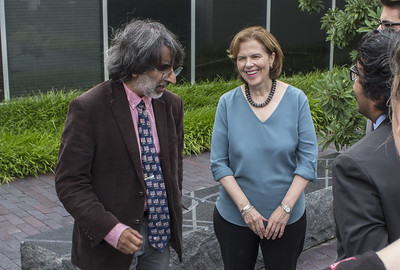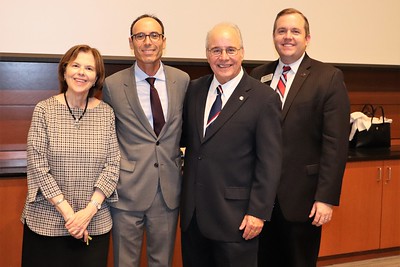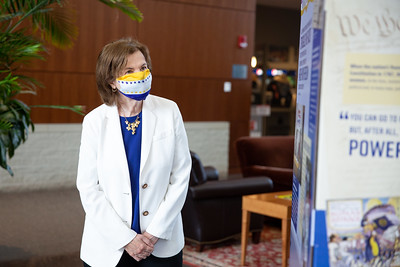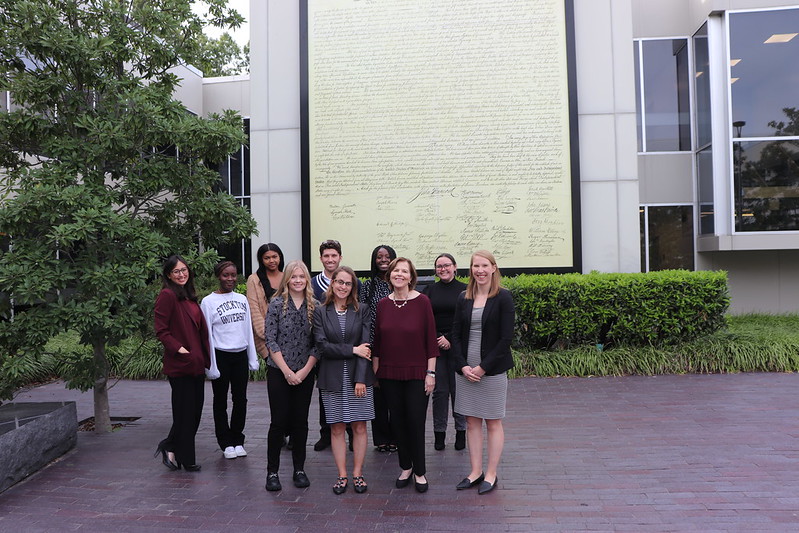An Interview with Professor Linda Wharton on Dobbs
By Valerie Hayes, Esq.
The following is a conversation between Valerie Hayes and Linda Wharton, professor of Political Science, on the recent Dobbs decision that has overturned Roe v. Wade.
Wharton's Background
Interviewer: Please inform our readers, especially our students, how you came to write the article, How New Jersey Protects Access to Abortion in the Aftermath of Dobbs that appeared in the New Jersey Lawyer.
Wharton: I joined the Stockton faculty in 2001. In the 1990s I worked as a lawyer for the Women's Law Project (WLP) in Philadelphia, a nonprofit legal organization that works to expand the rights of women, girls and LGBTQ+ people. Pennsylvania has a State Equal Rights Amendment (ERA) and over the years the WLP brought lots of successful litigation under that Amendment. For example, the WLP challenged the all-male admissions policy at Central High School in Philadelphia as violative of the state’s ERA. As a result of that challenge, Central High School became co-ed. As a result of my work at WLP, as a scholar I became interested in researching uses of state constitutional law provisions to protect access to reproductive autonomy.
A big part of my work at the WLP was reproductive rights. The Pennsylvania State Legislature historically has passed lots of restrictive laws around reproductive access. Two of our challenges went to the United States Supreme Court, including the one in which I was involved, Planned Parenthood v. Casey, 505 U.S. 833 (1992).

So that explains my focus on state constitutional law and my focus on reproductive rights as a scholar. I have published two articles on this topic. One, in the Rutgers Law Journal, evaluates the effectiveness of State Equal Rights Amendments in enhancing protection against sex-based discrimination.[1] The second article, published in the William and Mary Journal of Women and the Law, focuses on the use of state constitutional law provisions to protect abortion rights.[2] One article focuses broadly on how state ERAs are being used to enhance protection against sex discrimination and the other article focuses more narrowly on reproductive rights. After publishing those scholarly articles, I’ve subsequently given many presentations over the years on these topics, and I've developed an expertise in this area.
Last summer, I was approached by Robert Williams, a long-time law professor at Rutgers Law School and expert in state constitutional law, and John Connell, who is a very prominent New Jersey lawyer. They edited the issue of New Jersey Law Magazine in which my article appears. The issue is dedicated to celebrating the 75th anniversary of the New Jersey Constitution. They asked me if I would write an article about the New Jersey Constitution, as it applies to abortion access in light of Dobbs. They approached me before Dobbs was decided. Of course, we were all anticipating the outcome in Dobbs because of the leaked opinion.
Wharton's Opinion on Orginialism
Interviewer: The League of Women Voters wrote the following in its statement about Dobbs, “The crux of Dobbs is a highly constrained and antiquated view of what constitutes a fundamental constitutional right. Specifically, Justice Alito wrote that for a right to be protected by the Constitution, it must be either explicitly spelled out in the text or ‘deeply rooted in [our] history and tradition.’” In thinking about Roe v. Wade, 410 U.S. 113 (1973) and Planned Parenthood v. Casey, what meaning would you place on Justice Alito’s statement?
Wharton: The opinion is really a triumph for originalism. I teach about originalism in my constitutional law class here at Stockton. Originalism is a constitutional methodology that takes the approach that the meaning of the Constitution was and is forever fixed based on what it meant at the time it was adopted. So, it essentially views the Constitution as crystallizing an existing set of state practices forever. Under this approach, we're stuck with whatever was happening in the distant past. For example, in the case of the Fourteenth Amendment, we’re frozen in 1868 when the Fourteenth Amendment was added. I and many other scholars agree that this is a dangerous, extremely limiting method of interpreting the Constitution.
I think it’s also important to understand that the dangers of this narrow approach were compounded by the fact that Justice Alito and those who joined him relied on what many scholars believe is an inaccurate version of abortion history. The court basically ignored or discounted the reality that at common law, indeed, decades prior to the addition of the Fourteenth Amendment to the Constitution, abortion was legal, and it was commonly practiced up until the point of quickening when the pregnant person feels fetal movement.
It wasn't until later in the 1800s that bans on abortion came into place. So, in fact, we don't have a long history in this country of banning either abortion or contraception. Essentially, the Court compounded the dangers of originalism by relying on an inaccurate version of history.
Interviewer: Oh, my goodness, it's like we’re unpacking this onion. What you're sharing with me is not something a person who isn't studied on this topic would ever know. Amazing!

Issues Surrounding Government Involvement in Reproductive Health Decisions
Interviewer: Moving on to the third question. Who owns a woman's body? And why are the courts and politicians so involved in what appears to be a fundamental private health and socioeconomic decision?
Wharton: The Supreme Court of the United States, starting with Griswold v. Connecticut, 381 U.S. 479 (1965), which protected access to contraception, and then in Roe, involving access to abortion, has been involved in these issues. Historically, though, the Court has been involved to protect access to these fundamental rights from limitations imposed by politicians.
That’s been positive in that the Roe and Griswold Courts protected these fundamental rights. Dobbs, in contrast, turns everything on its head. It (Dobbs) allows politicians to control this issue. That’s what is problematic about Dobbs. I don't think the involvement of courts, if they're protecting access, is a problem; just like they protect our freedom of speech, religious freedom and those things. That’s the essential role of the judiciary in the area of fundamental rights--that they step in and be the guardians of these precious fundamental rights. The problem with Dobbs is it doesn’t regard these rights as fundamental anymore. Rather, it (Dobbs) allows politicians to control them.
Interviewer: This is scary stuff and a slippery slope to other kinds of rights too, I imagine.
Wharton: Yes, I think that’s what your fourth question is about.
The General Significance of the Dobbs Decision
Interviewer: Yes. Your article provides a nice timeline of the case law involving abortion, and ultimately a woman’s right to choose. If we assume for a moment that the Dobbs decision not only affected women’s right to choose, please explain why and how the Dobbs decision matters not only to women, but also their spouses, partners and families.
Wharton: Okay. The implications of this originalist analysis go beyond abortion. Justice Thomas openly called in his concurring opinion for an extension beyond abortion. Despite the efforts of Justice Alito and Justice Kavanaugh to suggest the contrary in their opinions, this originalist analysis that I described before can be used in the future by the court to extend to other things.
It logically can lead to upholding bans on same-sex marriage, bans on contraception, bans on certain forms of sexual intimacy. I believe we really disregard Justice Thomas and his opinion at our peril because he’s right that the originalist analysis could be extended beyond abortion access.
I think the good news is, and you may have read this week, that in the area of marriage equality we should see the passage soon at the Federal level of the Respect for Marriage Act (RFMA) that would at least solidify some protections at the Federal level. The RFMA would repeal the Defense of Marriage Act (DOMA) and require that people be considered married in any state as long as the marriage was valid in the state in which it was performed. As I understand it, it (RFMA) doesn’t require the states to issue marriage licenses to same-sex couples, but at least it shores up some protection at the Federal level for both same-sex and interracial marriages.
Of course, the Obergefell v. Hodges, 576 U.S. 644 (2015) opinion provides protection for marriage equality under our Constitution and holds that states must allow same-sex marriage. But there are a lot of scholars who are worried that, because of Dobbs and the Dobbs analysis, that Obergefell is also in danger just as Roe was in danger. We don’t know; we’ll see. Maybe Justices Alito and Kavanaugh were being genuine in their opinions, and they actually would not go that far. We just don’t know, but I think it’s really important to pass as many laws as possible to shore up protection for all of these rights. That’s what’s happening at the Federal level with the Respect for Marriage Act, which 12 Republicans voted for in the Senate.

Interviewer: I read an article about syndemics,[3] the synonym for co-morbidity. The article noted that “Changes in political and economic conditions (and interviewer adds legal conditions), and relatedly, the breakdown of protective health measures or infrastructure can induce differentially and additive detrimental effects on specific populations.” So, for example, how do you see the cascading impact of Dobbs on women who identify as African American, Latinx, Asian, Native American, including immigrant women, and their families?
Wharton: I’m happy to address that, and I’ll focus on abortion restrictions. There is no question that abortion restrictions disparately impact the most vulnerable women, e.g., young women, rural women, women of color, poor women and women who are victims of abuse in their relationships. This reality existed even prior to Dobbs. I’m going to give you some background here of which I’m sure you are aware.
Roe had great promise, but in the aftermath of Roe it was narrowly and disappointingly implemented by the Court in terms of the breadth and the scope of protection that was afforded both poor women, young women and other individuals seeking abortion. I'll give you a couple of examples. In 1980, in Harris v. McRae, 448 U.S. 297 (1980), for example, the Court held that states participating in Medicaid were not obligated to fund all medically necessary abortions. That significantly limited the promise of Roe. Then over the years, for example, the Court has upheld parental consent and notification laws for minors. As long as states allow the alternative of judicial approval, which is a daunting process, they can impose these parental consent requirements on minors. Those are just two ways in which, even before Dobbs, the Supreme Court allowed restrictions on abortion that fell disparately on vulnerable women and girls.
Even in Casey, although the Court reaffirmed Roe, it continued this pattern of cutting back on the promise of Roe. It allowed, for example, mandatory or forced waiting periods for 24 hours. I'll explain how that worked. If you were in a state that had a forced waiting period, you had to have an initial appointment with your provider, then go away and wait at least 24 hours before having your procedure. You had to come back for your (procedure) appointment.
This sounds like it would not be that all impactful, but 24 hours, in reality, was not 24 hours because providers don’t have appointments every day. There is a shortage of providers, so you cannot just turnaround and get your appointment the next day. In reality, the wait might be considerably longer than 24 hours. That situation may not be so problematic in smaller states where there are lots of providers; however, in rural America this is a big problem where you have to travel to get your procedure. So, if you have to travel 300 miles, and then you have to wait for your procedure, that involves hotel costs and taking time off from work. It can be very burdensome for certain groups of women.
So that’s why, in states like New Jersey, where we have these additional protections that we get from the state Constitution or state statutes, we’ve been very fortunate because we don't have these additional restrictions that have been so problematic for certain women.
Effects on Reproductive Rights for New Jerseyians
Interviewer: Your article discusses how the State of New Jersey is protecting a women’s right to choose and her reproductive rights. What do you see are the strengths, weaknesses, opportunities and threats in the approach New Jersey has taken to cement a woman’s fundamental rights in this area?
Wharton: New Jersey women, I would say, are well positioned through New Jersey’s State Supreme Court’s long-standing interpretation of the State Constitution, as well as the passage of statutes and regulations particularly under the Murphy administration. We’re very well positioned right now.
I think the danger, though, is that if there’s a conservative takeover, for example of the State legislature, there could be repeals of some of these statutes or administrative regulations or attempts to amend the State Constitution that could happen even in New Jersey. So, I think the more and more we can continue to embed protection right into our laws, that’s helpful to expand access to abortion in New Jersey. There are still some bills pending that would help women pay for abortion in New Jersey, for example, mentioned in the article.
Also, we have to remain vigilant in New Jersey at the polls and at the State level continue to elect people who will protect the right to choose. That’s really important, and that’s not going to go away. I think what happens sometimes is people get too comfortable. Rights can be eroded anywhere.
Experience as Co-Counsel in Planned Parenthood v. Casey
Interviewer: You may have touched upon this in some of your comments, but I understand you served as lead co-counsel in Planned Parenthood v. Casey which was also overturned by the Supreme Court in its Dobbs decision. So, thinking back to the preparation for that case, please briefly describe that experience for our pre-law and other students who might be thinking about becoming litigation attorneys.
Wharton: Yes, I was lead co-counsel in Planned Parenthood v. Casey, which was decided by the Court in 1992, and that’s a case that reaffirmed Roe v. Wade. I was relatively young at the time, and it was an honor to serve in this capacity. This was when I occurred when I worked at the Women’s Law Project. You'll be interested to know that I recently sent my papers in the Casey case to the Schlesinger Library at Harvard. They have a wonderful collection of women's rights related papers and historical memorabilia. They are doing conference in January to recognize would have been the 50th anniversary of Roe. Papers and memorabilia in their collection related to reproductive rights will be displayed. So, it’s a great honor to be able to send my papers there.

Over years I’ve continued to speak and write about and be an advocate for these issues. I’ve continued my work in different capacities, but it was a great privilege to be part of Planned Parenthood v. Casey. However, this past June was very painful for me. It was painful for lots of people to have Roe and Casey overturned, but it had particular meaning for me because Casey was overturned.
Wharton's Predictions Moving Forward
Interviewer: Do you have any additional comments to make on your article, the Dobbs decision, or the state of fundamental rights of women to choose, and potentially other fundamental rights held as constitutional that might be placed on the chopping block? So, I’m asking you for a crystal ball look and thinking.
Wharton: Well, I would say this not so much as a crystal ball, but I would just say again that the reality we find ourselves in is scary and painful. As a lawyer and a constitutional scholar, I’ve always had great respect for the Supreme Court, and frankly, I never considered myself a radical even as a practicing lawyer. I was working within and invoking long-standing constitutional values and precedents.
What scares me most is the current Court’s willingness to abandon the norms of those long-standing norms of constitutional analysis, doctrines like stare decisis which we all learn in law school, to just ignore past precedent, and to overturn it because they personally disagree with it.
And I’m worried that we’re going to see this Court doing that more and more. Just this month, for example, the Court heard oral arguments in a case in which they are reconsidering, long-standing Supreme Court precedent on racial affirmative action in higher education. Buckle your seat belts because that’s an area where there’s likely to be a tremendous amount of erosion. I hope I’m wrong, but we should all be prepared for erosion of precedent that we have lived with for decades and decades. These opinions have all been really important sources of legal protection that I’m very fearful are going to be eroded.
Interviewer: Well, I thank you so much. I am in the presence of greatness. This is wonderful. I've learned a lot, and I'm sure our readers will learn a lot as well.
Valerie Hayes is the chief officer for Diversity and Inclusion. Along with leading the charge on diversity, equity, inclusion and belonging work at Stockton, which has been recognized nationally, Hayes is always encouraging the Stockton community to join her in these efforts.
Related Articles:
References
[1]State Equal Rights Amendments Revisited: Evaluating their Effectiveness in Advancing Protection against Sex Discrimination, 36 Rutgers Law Journal 1201 (2006).
[2]Roe at Thirty-Sex and Beyond: Enhancing Protection for Abortion Rights Through State Constitutions, 15 William & Mary Journal of Race, Gender, and Social Justice 469 (2009).
[3] Syndemics: health in context. The Lancet, vol. 389, No. 10072.


